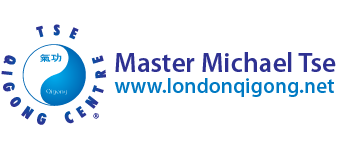Master Tse’s Qigong Dao #24
Dai Mai帶脈 Points
 After the Qi Hai氣海, Mingmen 命門, and Guan Yuan 關元 the next important points for the Dantian are the Dai Mai帶脈points. We use them a lot in Dayan Qigong forms as they are close to the Qi Hai point. They are found on the same level as the Qi Hai point, close to the hip bones. “Dai” means “Belt帶” and “Mai脈” means “Channel”. The Belt Channel is around the waist close to the hips bones. This area should be soft and when we press them we should not feel any pain. This means the Dai Mai points are working well. They are like the side windows into your Dantian丹田and just like a house needs windows to let in more air, the Dantian needs the Dai Mai points to let in more Qi.
After the Qi Hai氣海, Mingmen 命門, and Guan Yuan 關元 the next important points for the Dantian are the Dai Mai帶脈points. We use them a lot in Dayan Qigong forms as they are close to the Qi Hai point. They are found on the same level as the Qi Hai point, close to the hip bones. “Dai” means “Belt帶” and “Mai脈” means “Channel”. The Belt Channel is around the waist close to the hips bones. This area should be soft and when we press them we should not feel any pain. This means the Dai Mai points are working well. They are like the side windows into your Dantian丹田and just like a house needs windows to let in more air, the Dantian needs the Dai Mai points to let in more Qi.
The Dai Mai points belong to the Foot Xiao Yang Gall Bladder Channel 足少陽胆經 . It means they help the Gall Bladder if it has a problem. It is also good for the blood circulation and especially for ladies during menstruation, gynaecological problems, swollen stomach and hernias. This area should be soft and flexible and so we need to move the waist more. So practising Qigong helps open the Dai Mai points and so more Qi can be stored at the Dantian.
Michael Tse



Dear Sigong – Thank you for explaining the significance of Dai Mai. Reliable information about Dai Mai points and the Dai Mai meridian in general is very rare. I am studying Balancing Gong Opening and Closing the Dantien with Sifu Wallace. In addition to what you said, GB26 as described according to acupuncture theory (halfway between the ends of the 11th and 12th ribs and level with CV8 the umbilicus) has helped me with low back pain and low energy as well.
My first question is rather a bit technical. I was wondering if we are referencing the Dai Mai meridian in general here rather than the Dai Mai points specifically? Confusion arises regarding the labeling as Dai Mai points per se according to the chart – the point approximately along the nipple line seems closer to my mind to be Wei Dao GB 28 or Wailing ST26 at the same level with CV6 Qihai. Whatever we agree to call it, you are saying that these points relate to dantien in a lateral fashion, is that correct? My second question is if you could please describe a little further the nature of the location and size of the lower dantien or the feeling quality? Is it the womb area for a woman? Is it always the same or can it vary across individuals and across time?
Dear Jasmine -Rose,
Regarding of your question of the location of Daimai point, In China and for most Chinese people when they learn the acupuncture point they will learn the name of the acupuncture point instead of the number of the channel. I have never learned the number of the channel, so I do not know much about that, because the name is the meaning of the acupuncture point. The location of the Daimai point is same level of Qihai point and inside both sides of hip bone. All the locations of the acupuncture points is different from many different doctors, a lot of them have different explanation of that, all based on where they learned, who is the teacher or school. In our Dayan system we have our way to find the location of acupuncture point, because when we practise the way we practise Qigong we will at the end in deep relaxation to feel the location of the acupuncture point. Actually that is how the Chinese people in the past used to find out the acupuncture point. In the world there are 2 kinds of knowledge. One you can see and measure and one you cannot really see and measure. It takes year to understand Qigong, Wing Chun, Taiji Quan and Yijing. Even Buddhism and Daoism are like that, but those skill are very profound and teach us in spiritual and philosophical way, even change our life. If you trust your teacher, follow him and he will help you to understand the way we practise Qigong and make you healthy.
Sigong Michael Tse